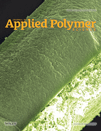Characterization and CO2 sorption properties of poly[methacryloxypropylheptacyclopentyl-T8-silsesquioxane- co-3-methacryloxypropyltris(trimethylsiloxy)silane]
Abstract
Poly[methacryloxypropylheptacyclopentyl-T8-silsesquioxane (MAPOSS)-co-3-methacryloxypropyltris(trimethylsiloxy)silane (SiMA)] was synthesized through free radical polymerization. The physical and carbon dioxide (CO2) sorption properties of the copolymer membranes were investigated in terms of the MAPOSS content. As the MAPOSS content increases, the membrane density increased, suggesting a decrease in the fractional free volume. In addition, the thermal stability was improved with increasing the MAPOSS content. These are because of the polyhedraloligomericilsesquioxane (POSS) units that restrict the high mobility of poly(SiMA) segments. The glass transition temperature, Tg of the copolymers was single Tg based on the differential scanning calorimetry, suggesting that the copolymers were random and not phase separation. Based on the CO2 sorption measurement, the POSS units play a role in reducing Henry's dissolution by suppressing the mobility of the poly(SiMA) component, while POSS units increase the nonequilibrium excess free volume, which contributes to the Langmuir dissolution. Based on these results, the introduction of MAPOSS unit is one of the effective ways to improved the thermal stability and CO2 sorption property due to the enhancement of the polymer rigidity. © 2013 Wiley Periodicals, Inc. J. Appl. Polym. Sci., 2013




